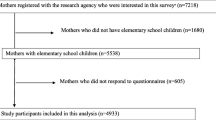Abstract
Aim
Tendency for taking dietary supplements is dramatically increasing. However, limited studies exist in this regard. We aimed to assess the frequency and determinants of dietary supplement use among a nationally-representative sample of Iranian children and adolescents.
Methods
This population-based cross-sectional study (the CASPIAN V) was conducted in students aged 7 to 18 years old in 2015. Multistage, stratified cluster sampling method was used to select participants from thirty provinces in Iran. Data regarding taking vitamin and mineral supplements were collected. Demographic information, anthropometric indices, physical activity, screen time and body image were also evaluated. Multivariate logistic regression model was used for analyses.
Results
The prevalence of dietary supplements use was 34.1% and the most popular dietary supplement was Iron (12.9%). Multivariate logistic regression showed that boys (0.84, 95%CI: 0.78, 0.91) and body image perception (OR: 0.84, 95%CI: 0.75, 0.94) used less dietary supplements compared to others. Children aged 11 to 14 years (OR: 1.15, 95%CI: 1.06, 1.26) and those with moderate family socioeconomic status (OR: 1.12, 95%CI: 1.007, 1.25) used more supplement compared to other groups. Moreover, those with higher paternal educational level (OR: 0.77, 95%CI: 0.64, 0.93) used less supplements. However, living area, family size, paternal occupation, children BMI, Intended weight loss, and body image by student did not indicate any significant association.
Conclusion
Our findings indicated that about one-third of Iranian children and adolescents used dietary supplements; iron supplements were the most frequent ones. Children aged 11 to 14 years, those with higher educated mothers and moderate family socioeconomic status used more supplements compared to others. However, boys, children with excess weight and those with high-educated parents used less supplements compared to others. More studies are needed to clarify the efficacy and safety of dietary supplements in different age groups in various societies.

Similar content being viewed by others
Data availability
The dataset supporting the conclusions of this article will not be shared publicly, to ensure participants’ privacy.
References
Ball SD, Kertesz D, Moyer-Mileur LJ. Dietary supplement use is prevalent among children with a chronic illness. J Am Diet Assoc. 2005;105(1):78–84.
Picciano MF, Dwyer JT, Radimer KL, Wilson DH, Fisher KD, Thomas PR, et al. Dietary supplement use among infants, children, and adolescents in the United States, 1999-2002. Arch Pediatr Adolesc Med. 2007;161(10):978–85.
Gahche J, Bailey R, Burt V, Hughes J, Yetley E, Dwyer J, et al. Dietary supplement use among US adults has increased since NHANES III (1988-1994). NCHS Data Brief. 2011;(61):1–8.
Butte NF, Fox MK, Briefel RR, Siega-Riz AM, Dwyer JT, Deming DM, et al. Nutrient intakes of US infants, toddlers, and preschoolers meet or exceed dietary reference intakes. J Am Diet Assoc. 2010;110(12):S27–37.
Dwyer J, Nahin RL, Rogers GT, Barnes PM, Jacques PM, Sempos CT, et al. Prevalence and predictors of children's dietary supplement use: the 2007 National Health Interview Survey. Am J Clin Nutr. 2013;97(6):1331–7.
Barnes PM, Bloom B, Nahin RL. Complementary and alternative medicine use among adults and children; United States, 2007. 2008.
Reaves L, Steffen LM, Dwyer JT, Webber LS, Lytle LA, Feldman HA, et al. Vitamin supplement intake is related to dietary intake and physical activity: the child and adolescent trial for cardiovascular health (CATCH). J Am Diet Assoc. 2006;106(12):2018–23.
Motlagh ME, Ziaodini H, Qorbani M, Taheri M, Aminaei T, Goodarzi A, et al. Methodology and early findings of the fifth survey of childhood and adolescence surveillance and prevention of adult noncommunicable disease: the CASPIAN-V study. Int J Prev Med. 2017;8.
Ernst E. Prevalence of complementary/alternative medicine for children: a systematic review. Eur J Pediatr. 1999;158(1):7–11.
Gardiner P, Buettner C, Davis RB, Phillips RS, Kemper KJ. Factors and common conditions associated with adolescent dietary supplement use: an analysis of the National Health and Nutrition Examination Survey (NHANES). BMC Complement Altern Med. 2008;8(1):9.
Yoon JY, Park HA, Kang JH, Kim KW, Hur YI, Park JJ, et al. Prevalence of dietary supplement use in Korean children and adolescents: insights from Korea National Health and nutrition examination survey 2007-2009. J Korean Med Sci. 2012;27(5):512–7.
Kobayashi E, Nishijima C, Sato Y, Umegaki K, Chiba T. The prevalence of dietary supplement use among elementary, junior high, and high school students: a Nationwide survey in Japan. Nutrients. 2018;10(9):1176.
Bailey RL, Gahche JJ, Lentino CV, Dwyer JT, Engel JS, Thomas PR, et al. Dietary supplement use in the United States, 2003–20061. J Nutr. 2010;141(2):261–6.
Rock CL. Multivitamin-multimineral supplements: who uses them? Am J Clin Nutr. 2007;85(1):277S–9S.
Akbari M, Moosazadeh M, Tabrizi R, Khatibi SR, Khodadost M, Heydari ST, et al. Estimation of iron deficiency anemia in Iranian children and adolescents: a systematic review and meta-analysis. Hematology. 2017;22(4):231–9.
Kleinman R. Pediatric nutrition handbook. Elk Grove Village: American Academy of Pediatrics; 2009. p. 359.
Acknowledgements
The authors are thankful of the team working on this national project and all participants who cooperated with this study.
Author information
Authors and Affiliations
Corresponding authors
Ethics declarations
Competing interests
The authors declare that they have no competing interests.
Ethics approval and consent to participate
The study was approved by the Research and Ethics Council of Isfahan University of Medical Sciences.
Additional information
Publisher’s note
Springer Nature remains neutral with regard to jurisdictional claims in published maps and institutional affiliations.
Rights and permissions
About this article
Cite this article
Namazi, N., Kelishadi, R., Heshmat, R. et al. Determinants of taking dietary supplements in Iranian children and adolescents: the CASPIAN-V study. J Diabetes Metab Disord 18, 409–417 (2019). https://doi.org/10.1007/s40200-019-00432-z
Received:
Accepted:
Published:
Issue Date:
DOI: https://doi.org/10.1007/s40200-019-00432-z




